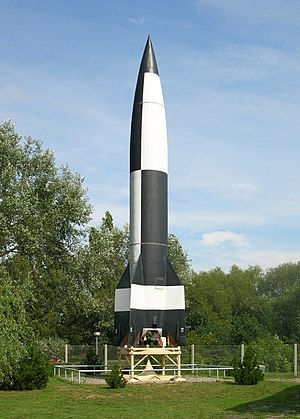V-2 rocket
| Aggregat-4/Vergeltungswaffe-2 | |
|---|---|

Peenemünde Museum replica of V-2
|
|
| Type | single-stage ballistic missile |
| Place of origin | Nazi Germany |
| Service history | |
| In service | 1944–1952 |
| Used by |
German Army SS Post-war: United Kingdom United States Soviet Union |
| Production history | |
| Designer | Peenemünde Army Research Center |
| Manufacturer | Mittelwerk GmbH |
| Unit cost | 100,000 RM January 1944, 50,000 RM March 1945 |
| Produced | 16 March 1942 – 1945 (Germany) Some assembled post-war |
| Specifications | |
| Weight | 12,500 kg (27,600 lb) |
| Length | 14 m (45 ft 11 in) |
| Diameter | 1.65 m (5 ft 5 in) |
| Warhead | 1,000 kg (2,200 lb) Amatol |
|
Detonation
mechanism |
impact |
|
|
|
| Wingspan | 3.56 m (11 ft 8 in) |
| Propellant | 3,810 kg (8,400 lb) 75% ethanol/25% water 4,910 kg (10,820 lb) liquid oxygen |
|
Operational
range |
320 km (200 mi) |
| Flight altitude | 88 km (55 mi) maximum altitude on long-range trajectory, 206 km (128 mi) maximum altitude if launched vertically |
| Speed |
maximum:5,760 km/h (3,580 mph) |
|
Guidance
system |
Gyroscopes to determine direction Müller-type pendulous gyroscopic accelerometer for engine cutoff on most production rockets |
|
Launch
platform |
Mobile (Meillerwagen) |
maximum:5,760 km/h (3,580 mph)
The V-2 (German: Vergeltungswaffe 2, "Retribution Weapon 2"), technical name Aggregat 4 (A4), was the world's first long-rangeguided ballistic missile. The missile with a liquid-propellant rocket engine was developed during the Second World War in Germany as a "vengeance weapon", assigned to attack Allied cities as retaliation for the Allied bombings against German cities. The V-2 rocket also became the first artificial object to cross the boundary of space with the vertical launch of MW 18014 on 20 June 1944.
Research into military use of long range rockets began when the studies of graduate student Wernher von Braun attracted the attention of the German Army. A series of prototypes culminated in the A-4, which went to war as the V-2. Beginning in September 1944, over 3,000 V-2s were launched by the German Wehrmacht against Allied targets during the war, first London and later Antwerp and Liège. According to a 2011 BBC documentary, the attacks from V2s resulted in the deaths of an estimated 9,000 civilians and military personnel, and a further 12,000 forced laborers and concentration camp prisoners died as a result of their forced participation in the production of the weapons.
As Germany collapsed, teams from the Allied forces—the United States, the United Kingdom, and the Soviet Union—raced to capture key German manufacturing sites and technology. Wernher von Braun and over 100 key V-2 personnel surrendered to the Americans. Eventually, many of the original V-2 team ended up working at the Redstone Arsenal. The US also captured enough V-2 hardware to build approximately 80 of the missiles. The Soviets gained possession of the V-2 manufacturing facilities after the war, re-established V-2 production, and moved it to the Soviet Union.
...
Wikipedia
